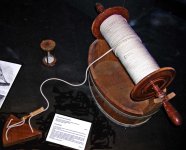PolarBear
Major
- Joined
- Feb 24, 2007
- Messages
- 6,706
I'm watching a 36 lecture course on DVD on the Rise and Fall of the British Empire. Today I learned the origin of the terms captain's log and knots. It all goes back to the era of exploration and navigation needed for blue water sailing in the 16th and 17th centuries when a log and a line with knots in it were thrown overboard to measure the ship's speed.
The first known device to measure speed is often claimed to be the Dutchman's Log. An object that would float was thrown overboard and the time required to pass between two points on deck was measured with a sandglass. However, the first reference to a Dutchman's log is in 1623, after the ship log.[1] The Dutchman's log could be used with a brass tobacco box, rectangular with rounded ends. This box had tables on it to convert log timing to speed.[2][3]
The log has been used by mariners for a long time. The first occurrence of a description of the device in print was in A Regiment for the Sea by William Bourne in 1574.
Initially, the log-line was not knotted and the length was measured directly on the line. With the introduction of the nautical mile as a standard unit of measure at sea in the 15th century, the line began to be marked at equal intervals proportional to the nautical mile and to the time interval used for measurement. Initially, the markings were in the form of knots in the line. Later, knotted cords were worked into the log-line.
Originally, the distance between marks was 7 fathoms or 42 feet used with a sandglass with a 30 second running time. Later refinements in the length of the nautical mile caused the distance between knots to be changed. Eventually, the distance was set to 47 feet, 3 inches (14.4 meters) for a standard glass of 28 seconds.
The name of the unit knot, for nautical mile per hour, was derived from this method of measurement.
So now the opening lines of the Star Trek series with it reference to the captain's log takes on a whole new context for me.
The first known device to measure speed is often claimed to be the Dutchman's Log. An object that would float was thrown overboard and the time required to pass between two points on deck was measured with a sandglass. However, the first reference to a Dutchman's log is in 1623, after the ship log.[1] The Dutchman's log could be used with a brass tobacco box, rectangular with rounded ends. This box had tables on it to convert log timing to speed.[2][3]
The log has been used by mariners for a long time. The first occurrence of a description of the device in print was in A Regiment for the Sea by William Bourne in 1574.
Initially, the log-line was not knotted and the length was measured directly on the line. With the introduction of the nautical mile as a standard unit of measure at sea in the 15th century, the line began to be marked at equal intervals proportional to the nautical mile and to the time interval used for measurement. Initially, the markings were in the form of knots in the line. Later, knotted cords were worked into the log-line.
Originally, the distance between marks was 7 fathoms or 42 feet used with a sandglass with a 30 second running time. Later refinements in the length of the nautical mile caused the distance between knots to be changed. Eventually, the distance was set to 47 feet, 3 inches (14.4 meters) for a standard glass of 28 seconds.
The name of the unit knot, for nautical mile per hour, was derived from this method of measurement.
So now the opening lines of the Star Trek series with it reference to the captain's log takes on a whole new context for me.


